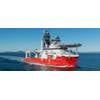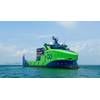US Wave Energy Set for Government Commercialization Boost of $112M

xWave wave energy device developed by U.S. company CalWave Power Technologies (Credit: CalWave Power Technologies)
The U.S. Department of Energy has made its largest ever investment in marine energy, making $112.5 million available for the commercialization of wave energy technologies.
This five-year investment is expected to significantly accelerate the design, fabrication, and testing of multiple wave energy converters (WECs), which harness power from ocean waves.
Administered by the Water Power Technologies Office (WPTO), the investment is designed to support development and testing of WECs to provide power for at-sea applications, such as ocean observation, aquaculture, and marine carbon dioxide removal, and that cover coastal community needs, such as power and clean drinking water production.
Also, the investment will support the development of WECs with utility applications, which may be tested at PacWave South, the first pre-permitted, grid-connected test facility for wave energy technologies in the continental United States that is expected to be operational next year.
The investment will help identify and mature high-potential WEC technologies, reduce financial risks for developers and incentivize investors, progress technologies at smaller scales while developing toward utility scale, and increase learning for installation, operations, and maintenance.
“Marine energy has great potential in the United States - the total available wave energy resource in the U.S. is equivalent to approximately 34 percent of all domestic power generation. The Department of Energy’s investment in wave energy will provide consistent, long-term funding to American developers so they can advance their technologies with the goal of providing millions of Americans with locally sourced, clean, and reliable energy,” said Jennifer M. Granholm, U.S. Secretary of Energy.
Energy from ocean waves is abundant and complementary to other renewable energy sources, like wind energy and solar power. Even if only a portion of this technical resource potential is captured, wave energy technologies would make significant contributions to U.S. energy needs by powering U.S. electric grids and at-sea activities, as well as rural and remote communities that often rely on expensive shipments of fossil fuels.
This investment will help identify and mature high-potential WEC technologies, reduce financial risks for developers and incentivize investors, progress technologies at smaller scales while developing toward utility scale, and increase learning for installation, operations, and maintenance.
The full funding opportunity is available in the Office of Energy Efficiency and Renewable Energy Program Information Center, with the concept papers due by October 25, 2024.













 December 2025
December 2025



